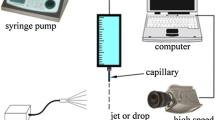Abstract
This paper presents an interpretation of the mechanism of drop formation due to bubbles of gas or vapour travelling upwards through a liquid and collapsing at the liquid-gas interface. Size-distribution of entrained drops are obtained as a function of height and bubble sizes. Parabolic trajectories have been taken in consideration and an equation is given for the maximum height of drops.
Zusammenfassung
Eine Erklärung für die Bildung von Tropfen an der freien Flüssigkeitsoberfläche beim Zerplatzen von aufsteigenden Gas- oder Dampfblasen wird hier gegeben. Die Größenverteilung der abgeschleuderten Tropfen wird als Funktion der Schleuderhöhe und der Blasengröße erhalten. Parabolische Schleuderbahnen wurden berücksichtigt und eine Gleichung für die maximale Schleuderhöhe der Tropfen angegeben.
Similar content being viewed by others
Abbreviations
- σ :
-
surface tension
- α :
-
amplitude of the surface disturbance
- γ w :
-
density of liquid
- γa :
-
density of gas
- ϑ :
-
kinematic viscosity
- D d :
-
diameter of droplet
- D j :
-
diameter of jet
- E d :
-
drop energy
- E j :
-
total energy absorbed by the jet
- E o :
-
energy release by collapsing bubble
- E p :
-
potential energy
- E R :
-
drag energy
- E s :
-
surface tension energy
- F :
-
vertical force
- G j :
-
gravitational force acting on jet
- H :
-
maximum trajectory height
- L :
-
length of jet
- L opt :
-
length of separated upper portion of jet
- l :
-
length unseparated lower portion of jet
- M :
-
mass of water which must be set in motion to fill the crater
- m :
-
mass of droplet
- P g :
-
gas pressure
- P l :
-
liquid pressure
- P i :
-
inside pressure
- P o :
-
outside pressure
- R 1,R 2 :
-
curvatures of bubble
- R j :
-
radius of jet
- R :
-
radius of spherical bubble
- R*:
-
frictional drag force of jet
- R D :
-
frictional drag force of droplet
- S 1 :
-
surface tension force
- t F :
-
impulse time
- t :
-
time of break-up of jet
- U :
-
mean velocity acquired by the massM
- v :
-
droplet velocity
- V 0 :
-
initial velocity of droplet
- W 1 :
-
gravitational force
Literature
Panasenko, M. D.: Proceedings of Conference on Designing Thermo-Technical Plants. Acad. Sci. USSR Press 1938.
Kruzhiliss, G. N.: Sovetskoi Kotloturbostroenic No. 1 and 4 (1945).
Stumpner, R.: Die Wärme, Bd. 59 (1936) S. 463.
Sterman, L. S.: J. Tech. Phys. USSR, Vol. 28 (1957) No. 7.
Davis, R. F.: I. Mech. E. Proc., December 13 (1940) London.
Edgerton, H. E., K. J. Germeshausen andH. E. Grier: a) High-Speed Photography. Photographic J., April 1936, p. 198. b) Flash. 1939 Hale, Cushman and Flint, New York.
Newitt, M., N. Dombrowski andF. Knelman: Trans. Inst. Chem. Engrs. Vol. 32 (1954) p. 244/261.
Castleman, R. A.: Bureau of Standards J. of Research, Vol. 6 (1931) p. 369/375.
Rayleigh, L.: a) Proc. Lond. Math. Soc., Vol. 10 (1879) p. 4.
: b) Phil. Mag. Vol. 48 (1899) p. 321.
Weber, C.: Angew. Math. Mech. Bd. 11 (1931) p. 136.
Haenlein, A.: Forsch. Ing. Wes. Bd. 2 (1931) S. 139.
Sitkei, G.: Kraftstoffaufbereitung und Verbrennung bei Dieselmotoren. Berlin/Göttingen/Heidelberg: Springer 1964.
Byrd-Friedman: Handbook of Elliptic Integrals for Engineers and Physicists. Berlin/Göttingen/Heidelberg: Springer 1954.
Author information
Authors and Affiliations
Rights and permissions
About this article
Cite this article
Aybers, N.M., Dagsöz, A.K. The mechanism of drop formation from gas or vapour bubbles. Wärme- und Stoffübertragung 1, 80–86 (1968). https://doi.org/10.1007/BF00750789
Received:
Issue Date:
DOI: https://doi.org/10.1007/BF00750789




